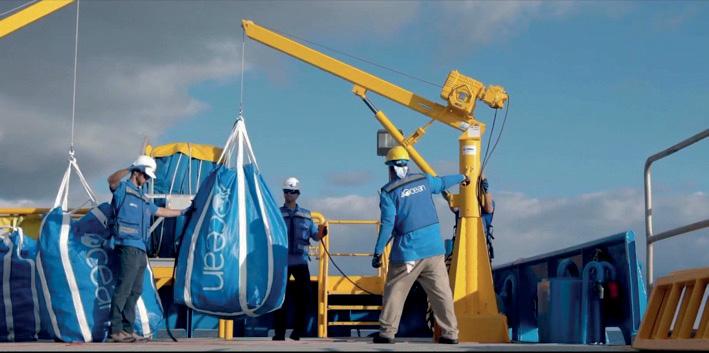
4 minute read
Lift Guidance
LEEA SOUNDS LIFTING WARNING
Ben Dobbs, Head of LEEA Technical Services, underlines the importance of ensuring correct lifting practices are in place and that there can be a big price to be paid if things go wrong
For the past 75 years, the Lifting Equipment Engineers Association (LEEA) has been established as the leading representative body for all those involved in the lifting industry, worldwide. With a membership spanning public and private companies, the group is involved with the training and setting of standards right through from health and safety, the provision of technical and legal advice to the development of examination and licensing systems.
In this article, LEEA draws attention to the importance of and requirement to ensure correct lifting practices are in place against a backdrop of referencing that recent cranerelated fatalities have resulted in, “multi-million pound fines, corporate failure, disbarment from being a director and in some cases jail sentences.”
Indeed, Dobbs explains that in the area of ‘wet logistics,’ maritime and port operations, smooth operations depend on the ability to complete lifting activities on a reliable basis to ensure minimised downtime. Yet efficiency must be complemented by safe working at all times. Failure to comprehend this basic fact, can result in severe consequences beyond handicapping a company’s day to day progress - an accident, a visit from health and safety inspectors and, ultimately, punishment.
FAILURES ARE AVOIDABLE
Dobbs underlines that failures are entirely avoidable if all parties in the chain of responsibility perform their roles correctly and there is an understanding that lifting equipment has to be looked after. He states, for example: “Regular inspection on the structure of a port crane – its sheaves, the jib and the slew mechanism are just some of the areas of focus for maintenance programmes carried out in Wet Logistics.”
Another area of concern in Wet Logistics operations that LEEA is keen to highlight involves One Trip Slings. These are designed for the specific purpose of attaching to, and accompanying, a specific load from source, through a defined number of handling operations, until the cargo reaches its final destination. Then, once the cargo reaches its final destination the sling must be destroyed and not reused.
One of the main routes for one trip slings into a country is via cargo being discharged in ports but, as Dobbs points out, a lack of awareness of the one-time usage criteria with these slings can lead to their free passage out of the docks, rather than being destroyed once removed from the cargo. “Failure to do so and continuing to use them puts users at risk. Duty holders will be culpable in the event of failure and injury to persons, for not executing an adequate lift plan and taking adequate precautions to reduce the risks associated with these slings,” he argues.
This factor leads directly into another area of specific importance that LEEA highlights – namely, legal responsibilities. Here, the Duty Holder in a Wet Logistics operation is the individual responsible for the lifting equipment in service within their port or terminal operation – usually an employer or self-employed person, facility owner, person in charge of the equipment or a hire company.
The concern, according to Dobbs, is that if the individual involved does not possess the skills or knowledge required, it is necessary to delegate to qualified personnel or organisations. This does not absolve them of responsibility, but it does change the nature of their accountability.
In addition, the Duty Holder must ensure that those undertaking the tasks are suitably qualified, experienced, trained and equipped – in short, competent for their task. Consequently, all employees and sub-contractors undertaking the task must be assessed, properly trained and provided with the necessary equipment for their role. For external organisations, the Duty Holder must have procedures in place for vetting their competency. in ports but, as Dobbs points out, ne-time usage criteria with these passage out of the docks, rather removed from the cargo. “Failure use them puts users at risk. Duty the event of failure and injury to an adequate lift plan and taking educe the risks associated with y into another area of specific highlights – namely, legal Duty Holder in a Wet Logistics al responsible for the lifting n their port or terminal operation self-employed person, facility he equipment or a hire company. o Dobbs, is that if the individual the skills or knowledge required,

8 The new LEEA
Code of Practice for the Safe Use of Lifting Equipment (COPSULE) is now available to download free
RECOMMENDED CODE OF PRACTICE
LEEA’s latest and freely available product, COPSULE, is a recommended Code of Practice, providing expert guidance on safe lifting practice. It offers comprehensive guidance on safe lifting practice; authoritative information written by impartial industry experts; up to date industry practice; and globally applicable guidance. 8 The LEEA Code of Practice for the Safe Use of Lifting Equipment (COPSULE) is now available to download free. The PDF version of the LEEA COPSULE Edition 9 can be found in the LEEA Document Library at leeaint.com LEEA Document Library at leeaint.com
8 Ben Dobbs, LEEA










